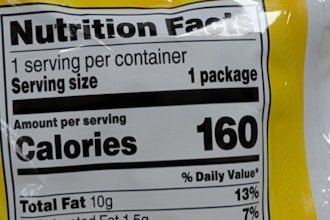

SILVER SPRING, Md., Sept. 27, 2016 (PRNewswire-USNewswire) — (FDA Voice Blog) With final rules on the Nutrition Facts label published, consumers soon will see an updated label on food packages that makes the calories and serving sizes of products easier to see and that gives them additional nutrition information, such as added sugars, vitamin D, and potassium.
The marketplace is teeming with rows and rows of foods — some new and some not; some healthier than others. Even for the well informed, choosing what to buy is challenging, especially if you want to choose a healthy diet for you and your families.
We know that many consumers use the Nutrition Facts label, especially when they are buying a food for the first time. Often, there are also a lot of other terms on food packages such as "healthy," "low in fat,"or "good source." We also know that many just don't have the time to consider the details of nutrition information on every package they purchase. In fact, most purchase decisions are made quickly, within three to five seconds.
That's why we're looking at how we define the claim "healthy." Companies can use this and other claims on the front of packages of foods that meet certain criteria to help consumers quickly identify nutritious choices.
As our understanding about nutrition has evolved, we need to make sure the definition for the "healthy" labeling claim stays up to date. For instance, the most recent public health recommendations now focus on type of fat, rather than amount of fat. They focus on added sugars, which consumers will see on the new Nutrition Facts label. And they focus on nutrients that consumers aren't getting enough of, like vitamin D and potassium. By updating the definition, we hope more companies will use the "healthy" claim as the basis for new product innovation and reformulation, providing consumers with a greater variety of "healthy" choices in the marketplace.
We have started to consider the criteria or terms for an updated definition of "healthy" but don't have all the answers. As a first step, we are asking for public input on a range of questions about what "healthy" should mean from a nutrition perspective and how consumers understand and use "healthy" food label claims.
For example, what current dietary recommendations should be reflected in the definition of "healthy"? What are the public health benefits of defining the term "healthy"? What do consumers expect of foods that carry a "healthy" claim? What factors and criteria should be used for the new definition of "healthy"? We are also planning to hold public forums to get additional input and inform us of what a broad range of stakeholders and consumers think. This may take some time, but we want to get it right.
While we are considering how to update the term "healthy" as a nutrient content claim, food manufacturers can continue to use the term "healthy" so long as certain criteria are met.
While we are working on the "healthy" claim, we also will begin evaluating other label claims to determine how they might be modernized. We want to give consumers the best tools and information about the foods they choose, with the goal of improving public health. And, we will also engage with industry to explore other ways to encourage companies to change their products to have better nutrition profiles. The end result will be more healthy dietary choices for consumers, and that is a worthy goal.





















